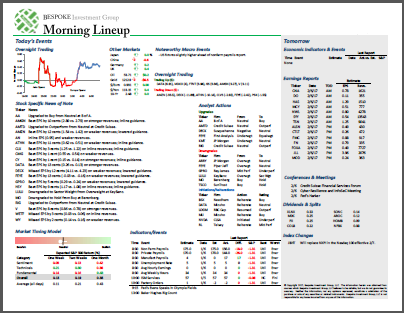See what’s driving market performance around the world in today’s Morning Lineup. Bespoke’s Morning Lineup is the best way to start your trading day. Read it now by starting a two-week trial to Bespoke Premium. CLICK HERE to learn more and start your trial.
“Wilderness is impersonal. It does not care whether you live or die. It does not care how much you love it.” – Lee Whittlesey
Below is a snippet of commentary from today’s Morning Lineup. Start a two-week trial to Bespoke Premium to view the full report.
The new month has started quietly in terms of equity futures trading, but activity will pick up at 10 AM Eastern with the releases of Construction Spending, Michigan Sentiment, and ISM Manufacturing data. Beyond the data, upcoming Fedspeak holds particular interest following a busy data week. Outside the US, Asian and European markets began March positively. In China and Japan, PMI Manufacturing data meets expectations, while the same report for Europe exceeded expectations but remains firmly in contraction.
152 years ago today, President Grant signed legislation officially recognizing Yellowstone as the first national park in the country. One of Yellowstone’s highlights has always been Old Faithful. While hundreds of geysers reside in the park, Old Faithful is unique as its eruptions can be predicted with relative accuracy. Since its discovery in the 1800s, and likely for millennia before, it has erupted at consistent intervals. Geologically, Old Faithful is exceptionally reliable, but eruption intervals have lengthened from just over an hour in the 1930s to an average of 90 minutes since 2000. And no, climate change is not the culprit; geologists attribute the change to subterranean earthquakes altering water levels. While Old Faithful has been one of the most reliable geysers for centuries, its continuation is far from guaranteed. If you haven’t witnessed it, make sure you do.
Markets, like most geological patterns and global changes, are impossible to predict. However, investors seem to have their own “Old Faithful” – the S&P 500’s consistent monthly gains. While bulls have enjoyed the last four months, it’s safe to assume that when the current streak ends, Old Faithful will still erupt roughly every 90 minutes. Yellowstone historian Lee Whittlesey’s words about nature aptly apply to markets: they are impersonal, indifferent to individual wins or losses, and unconcerned with how attached you are to a particular investment.
February saw the latest S&P 500 monthly gain of 5.2%, impressive in any market. This raises the question of whether investors typically take profits after such significant gains in the early days of a new month. While the historical record is mixed, some initial weakness in March wouldn’t be surprising.
The table below shows instances since 1953 (the first full year of the NYSE’s current five-day trading week) where the S&P 500 rallied over 4% in February, along with its cumulative month-to-date (MTD) performance in the first five trading days of March. Of the nine prior occurrences, the first day of March had an average and median positive return, but the S&P 500 only closed higher slightly more than half the time. The second day generally saw positive and consistent returns, with MTD gains in eight out of nine instances. However, MTD returns declined thereafter. By the fifth trading day, while the average performance remained positive (+0.44), the median change was a modest decline (-0.07%), with gains occurring only four out of five times. This compares to an average gain of 0.30% and positive returns 61% of the time for all other Marches since 1953. Overall, these figures are inconclusive, but as mentioned earlier, some weakness at the beginning of the month wouldn’t be unexpected.
For more analysis of global equities and economic readings released this morning, read today’s full Morning Lineup with a two-week Bespoke Premium trial.


